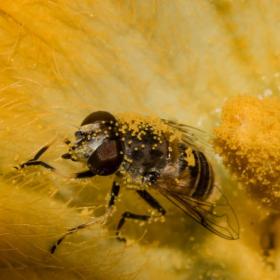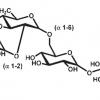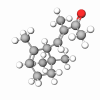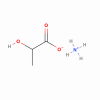Pollen is as per scientific diction the male principle of the plant which is transported by the wind or the bees to the female flower to pollinate it. Pollen is the product, collected and formed into grain by the bees. The pollen is collected by bees with specially developed legs (Hosea). With the bee's own secretion (spittle) it is formed to a grain of 2-5 mm.
Normally, the collecting bee hands over the pollen to a worker bee in the beehive for storage or feeding. The bee-keeper is using a pollen trap at the entrance of the beehive. The pollen slipped off when passing the entrance. Then the product is dried up to 9% if possible and stored.
The annual collection result is 30 - 80 kg per colony depending on the region and situation of the bees and their environment. A large part is needed for the feeding of the colony. Pollen mainly comes from the upland regions (400 - 1,400 m above sea level).
Components
- Reducing sugar: approx. 20%, not reducing sugar: approx. 5%,
- proteins: approx. 20%,
- free amino acids: approx. 10%,
- starch, other carbohydrates: approx. 5%,
- water: approx. 4%,
- ash: approx. 3%.
Application
Not only due to the high amount of amino acids and mineral nutrients, trace elements, vitamins, and unsaturated fatty acids Bee pollen is a whole super-food (only fiber is missing). To ease the use by the human organism. It is not only offered as natural granular but also as in enzymatic and physically opened form.In combination with the also present enzymes, native antibiotics, and hormones it is a perfect natural skincare ingredient that nourishes skin, provides optimal hydration and protects from harmful bacteria. Pollen is an ideal supplement delivering all the necessary essentials for the skin including NMFs (natural moisturizing factor amino acids), energizing and microbiota-balancing sugars, and protecting antioxidants, fatty acids, and vitamins.
Size
Pollen is very small (< 10 p up to 200 p) so that humans cannot harvest/collect it. Approx. 65% of the European pollen is smaller than 50pm in diameter. Only if the bees collect irregular grains of 2-5 mm diameter arise.
Structure and Difference
Cytoplasma, Intine, Exine (Tectum, Columellen), Exinomamente. The count in analyses is generally 300 - 500 kinds of pollen. Characteristics are:
- amount of the cells (single or assembled grains),
- size of the grains,
- form of the grains,
- development of the germ place (porat coplat, coporat),
- development of the exine,
- color,
- lid,
- growth.











